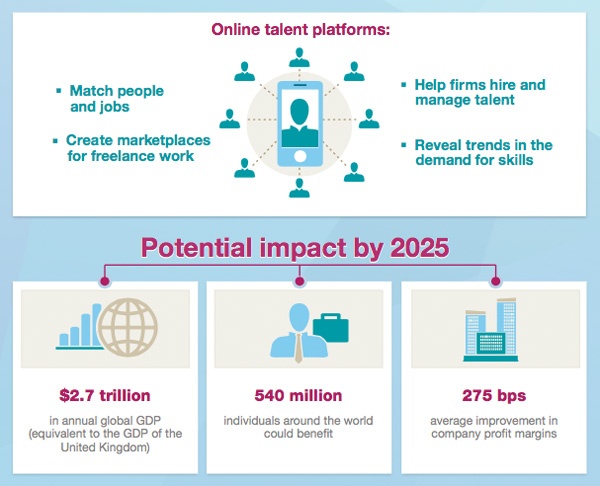In past blogs we have explored the “how tos” and evolving approaches towards the process of organizational design. In this fourth blog of a five part series on innovative and emerging alternatives for the organization of the workplace, organizational design expert David Creelman explores the online talent platforms being created around the world to leverage a global pool of skilled workers.
Which company is bigger: the famous advertising giant WPP with 180,000 employees, or the little known talent platform Tongal with 48 employees? At the moment, WPP is bigger….but the difference isn’t as great as you might think. If you ask Tongal to make a commercial for you, they don’t rely on their 48 employees; they rely on their talent community of 70,000 free agent professionals.
The talent platform design
Talent platforms are a new form of organization and they are growing like mad.
Most famous of all is Uber, which narrowly specializes in providing taxi services. Best established is Upwork, with 15 years of success behind them and one billion dollars in revenue. Rather than focusing on one type of work, Upwork has freelancers who can do all kinds of virtual projects. Want in-person work? Look for a talent platform like Wonolo or TaskRabbit. Looking for senior managers and professionals? Try the MBA & Co talent platform.
A true talent platform is not simply a marketplace that connects companies to freelancers. It is a system for getting work done. For example, Topcoder doesn’t dig up a good programmer for you; they design and run contests so that you get the best possible code. Free agents do the work, but the platform does everything in its power to create a system that ensures a good work product.

Advantages and disadvantages
As with the virtual organization, the massive advantage of the talent platform is that it escapes the burden of paying and parenting an army of regular full-time employees. In fact, the talent platform organization might be considered a type of virtual organization. The classic virtual organization taps a relatively small number of free agents with whom it has close relationships and that it manages as individuals, whereas a talent platform is more likely to tap tens of thousands of free agents and relies on systems to manage the work.
It is easy to see that a group of committed, carefully vetted, full-time employees working together would outperform a motley mix of freelancers. But does the benefit justify the huge cost of having employees? And are the employees a smart, enthusiastic, energetic team or more like the folks we saw on the television show “The Office”?
What it means to you
Whatever work you need to get done, whether you need a TV commercial, legal work, data entry or a computer program, you might find that a talent platform can do it better than the employees of traditional firms or agencies. Even more radical, perhaps your organization should consider transforming itself into a talent platform. Every professional services firm should be asking this question. It might be the best form of organizational design for the business.
 David Creelman is CEO of Creelman Research. He helps organizations identify, make sense of, and address important new issues in human capital. His work with Andrew Lambert on one such issue (board oversight of human capital) won the Walker Award. His work with Wanda T. Wallace on “leading when you are not the expert” topped the “Most Popular List” on the Harvard Business Reviews blog. His much endorsed book on the on-demand economy & future of work is called Lead the Work: Navigating a world beyond employment. It is coauthored with USC professor J. Boudreau and Towers Watson thought leader Ravin Jesuthasan. David lives in Toronto. To get in touch email [email protected].
David Creelman is CEO of Creelman Research. He helps organizations identify, make sense of, and address important new issues in human capital. His work with Andrew Lambert on one such issue (board oversight of human capital) won the Walker Award. His work with Wanda T. Wallace on “leading when you are not the expert” topped the “Most Popular List” on the Harvard Business Reviews blog. His much endorsed book on the on-demand economy & future of work is called Lead the Work: Navigating a world beyond employment. It is coauthored with USC professor J. Boudreau and Towers Watson thought leader Ravin Jesuthasan. David lives in Toronto. To get in touch email [email protected].
One of the challenges, of course, of keeping track of all those team members on your online talent platform, and how they all work together as a coherent team, is the basic challenge of keeping everyone organized, aligned, connected and communicating.
You have the same challenge if you or your band of virtual workers are plugging in to several different organizations while running concurrent projects for them. How do you keep everyone on their teams straight.
Organimi’s cloud based org charts, photoboards and directories are the very easiest way to get that done. Set them up in minutes and you have a complete solution in place: import your roster, create the roles, and fill them with your team members. Easy as 1 – 2 – 3. And now with custom fields so you can capture and display some of your own organization specific metrics and needs.
Whether you are doing it for your own organization, or helping someone else set up theirs….Organimi is the best cloud org chart solution to meet your needs.
We’re just crossing 28,000 organizations now, up from 7,500 this time last year.
We now have hundreds of customers who have opted for a paid plan so that we can continue to invest in improving the product. We appreciate the support….Keep the feedback coming!
As always, thanks for reading.

